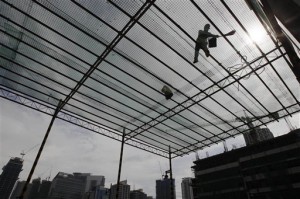Property boom transforming Philippine skylines

A worker cleans a steel screen roof as construction booms at a newly developed commercial and residential site in suburban Taguig City, south of Manila on Thursday July 5, 2012. As a Philippine property boom gathers pace, even Paris Hilton, Donald Trump and high-fashion house Versace are getting a piece of the action. AP PHOTO/AARON FAVILA
MANILA, Philippines—As a Philippine property boom gathers pace, even Paris Hilton, Donald Trump and high-fashion house Versace are getting a piece of the action.
The good times are into their fourth year, fueled by steady economic growth, Western firms offshoring jobs to the Philippines, the buying power of millions of Filipinos working abroad and low interest rates.
“It just so happens that today the stars are aligned… we have never seen the economy this bullish,” said Antonino Aquino, president of Ayala Land, one of the country’s biggest property developers.
Ayala Land is one of the main players in what industry figures describe as an unprecedented construction boom that is transforming the skyline of the nation’s capital, as well as many provincial cities.
In Manila, formerly sleepy pockets such as the Fort army base and the rundown Eastwood industrial zone have become chic, new business districts, catering mainly for the fast-growing outsourcing sector.
Article continues after this advertisementAt the Fort, Ayala Land this year broke ground on its $714-million One Bonifacio High Street project, which when completed in 2017 will host the Philippine Stock Exchange, a Shangri-La hotel, and retail outlets.
Article continues after this advertisementThe project also has a 63-story residential tower, with 298 suites ranging from $500,000-$1.9 million that sold out last month in 96 hours, according to the company.
Across the country, more than 850,000 square meters (9.1 million square feet) of office space and 14,000 residential units will enter the market this year, property consultants CBRE Philippines said in a report.
It said many of the residential units catered for a growing middle class on the fringes of Manila and other urban centers.
The building boom has also spread to hotels, shopping malls and casinos, triggering hopes of a long-anticipated take-off of the underdeveloped tourism industry.
Three of the world’s biggest gaming industry leaders are building a $4-billion, 100-hectare (247-acre) Entertainment City complex of casinos on Manila Bay. The first of the casinos are set to open early next year.
Meanwhile, Trump, the New York mogul, has put his name to a $150-million, 56-story, curtain-glass-walled Trump Tower that broke ground in the financial district this year.
“High-end buyers look for key differentiated features,” said Robbie Antonio, managing director of Century Properties that is behind the Trump Tower development.
He said 70 percent of the 220 residential units, which are worth up to $1.86 million each, have been sold.
The firm is putting up a nearby tower designed by the Versace fashion house – the first of its kind in Asia – featuring individual wading pools as well as its iconic Medusa-head brand imprinted on lamp shades and cutlery.
Century also flew in socialite and hotel heiress Hilton to Manila last year to help design and promote a suburban Manila residential project that features a man-made beach.
Industry players say the property boom reflects the overall status of the nation’s economy as it picks up steam after decades of underperforming compared with many of its Asian neighbors.
The economy grew 6.4 percent in the first quarter, the stock market has surged 20 percent this year to hit all-time highs, and the country’s credit rating has been bumped up to just a step below investment grade.
The central bank’s benchmark interest rates are also at historic lows – 4.0 percent for the benchmark borrowing rate – ensuring large piles of cheap cash for property development.
Aside from the macro-economic picture, real estate analysts point to the outsourcing phenomenon as one of the key drivers of the property boom.
From virtually nothing a decade ago, outsourcing now employs more than 600,000 people and is worth $11 billion annually, according to the main industry association which is forecasting 15 percent growth in the years ahead.
Many of the skyscrapers are being built to cater for the outsourcing workforce, which performs a myriad of tasks from call center duties to designing architectural plans for foreign firms.
Meanwhile, roughly nine million Filipinos who work overseas are sending large chunks of the $22 billion they earn – equal to 10 percent of the nation’s gross domestic product – back home, often investing in real estate.
The frenetic building pace has some quarters anxious over a potential property bubble, with the global economic woes adding to concerns.
But Rick Santos, CBRE Philippines chief executive, remains bullish, in large part because of the expected continued growth in the outsourcing sector.
“As economies in the West tighten, global companies will see it in their interest to outsource their non-core functions to save on costs,” Santos told an industry briefing recently.
Ayala Land’s Aquino also said the local market had not seen the price bubbles that preceded crashes in other countries, where property values suddenly doubled or tripled.
“The price increases have been very close to or a little more than the inflation rate,” Aquino said.
Trump Tower developer Antonio added: “We are confident that there’s still a demand that has to be met.”